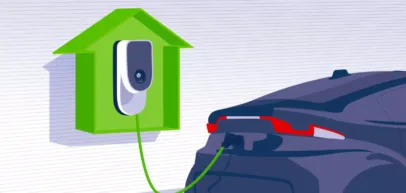Thinking of Buying an Electric Car? Here's What You Need to Know About Charging at Home
The way we drive is changing. From the horse & buggy, to the Model T, to the electric vehicle, the way we get around is always being upgraded. It’s estimated that by 2050, over 40% of all cars on the road will be electric. With such a major shift happening, it’s best to get informed early on before making a major decision such as purchasing an electric vehicle. Here’s what you need to know about charging an electric vehicle (EV) at home, as well as an overview of your other options.
Volkswagen Electric Vehicles
Volkswagen is planning to invest $2 billion over the next decade to support U.S. electric-car infrastructure. This initiative will include new stations and is actually related to their diesel emissions scandal settlement. The plan is to attack four 30-month plans with an investment of $500 million each. California topped the list for targeted metro areas. Volkswagen is currently taking pre orders for their first electric vehicle, the ID.4, which is a spin off of the classic VW Bus.
Tesla Electric Vehicles
Tesla is the first major player in the EV sphere & is committed to developing a nationwide network of electric-car stations which they call “superchargers”. Drivers owning Model S sedan and Model X crossovers get free charging for the first 1,000 miles annually whereas Model 3 drivers must pay a fee. As of 2020, the company had 908 supercharger stations across the U.S. However, Tesla’s are compatible with other public outlets and can also be charged in the home.
Ford Electric Vehicles
The company had already committed $11 billion to developing electric vehicle technology between 2018 and 2022, but in the earnings announcement Ford announced it will up the ante by an additional $11.5 billion, bringing its total investment in EV to $22 billion between now and 2025. Ford began selling its new all-electric Mustang this year car buyers should expect to see a lot more electric-powered Fords on the lot in the years to come.
Workplace EV Charging Stations
Another place you might start to see more charging stations is in workplace parking lots. This can prove to be an added draw for the growing number of electric car enthusiasts. Workers can pull up to a charger and allow it to charge while they work. Between home and work chargers, drivers will never need to worry about losing power.
Public EV Charging Stations
If your work doesn’t have a designated parking lot, and you rely on street parking, you won’t be likely to find a spot to charge. It’s really not something that is on the radar of most American suburbs, let alone cities even though you can find them in other countries. Curbside charging just isn’t a priority for U.S. infrastructure.
EV Charging Station Charging Speeds
As more electric cars are sold, more funding becomes available to design improved technologies. The goal here will be to create electric vehicles and chargers that can be completely charged in just 10 minutes. However, auto companies might not be ready to commit to reconfiguring battery chemistry and vehicle electronics to see this happen any time soon. This also poses issues for charging stations who will need capabilities to adapt to this type of battery upgrade.
Charging an Electric Vehicle at Home
That brings us to home charging stations. You can buy a charging station for as little as a few hundred or upwards to a few thousand dollars allowing you to conveniently charge your car overnight. This is the most likely way people will charge their cars in the future, as currently, 80% of electric car owners do so today. Homeowners can choose between the Level 1 electric vehicle supply equipment (EVSE) or Level 2 EVSE. While Level 2 EVSEs are faster, they also need special equipment.
This makes Level 2 EVSEs more expensive, as well as more difficult to install. Both types of EVSEs require secure storage of the charging cord to avoid damage. As well, you should keep an eye on the accessible EVSE parts to look for signs of wear. Proper maintenance requires cleaning now and then to get longer use from your charger.
Costs for Home Charging
The chances are high that you brought your EV to save the planet and to save on fuel costs. You definitely will pay less than gas, or diesel with an average of 12.6 cents/kWh. For a fully charged vehicle, you’re looking at about the same cost of running your air conditioner for six hours. It’s even less for hybrid electric vehicles because they have much smaller batteries, and also run on gasoline. According to General Motors, the annual energy use of a Chevy Volt is 2,520 kWh which would only cost about $320 a year to charge. If you get off-peak savings at night (which you should), you can see even more savings. The average retail gasoline prices can be as high as $1,500 a year, so it’s clear to see the benefits
Charging an electric vehicle overnight
So how far will an average overnight charge get you? It varies from car to car, but a Tesla Model 3 will travel at least 220 miles, while GM’s Bold will go at least 238 miles. If you consider the average American travels roughly 25 miles a day, you can get a pretty nice run on a single overnight charge, depending on your commute.
If you are looking for more information about EV charger installation in Bentonville, Bella Vista, or Fayetteville or electric car chargers in Northwest Arkansas, Fort Smith River Valley & Missouri, get in touch with us at Paschal Air, Plumbing & Electric today.
Electric Resources

Electric
How to Choose the Right EV Charging Station for Your Home

Electric
Electrical Safety Basics for Homeowners





